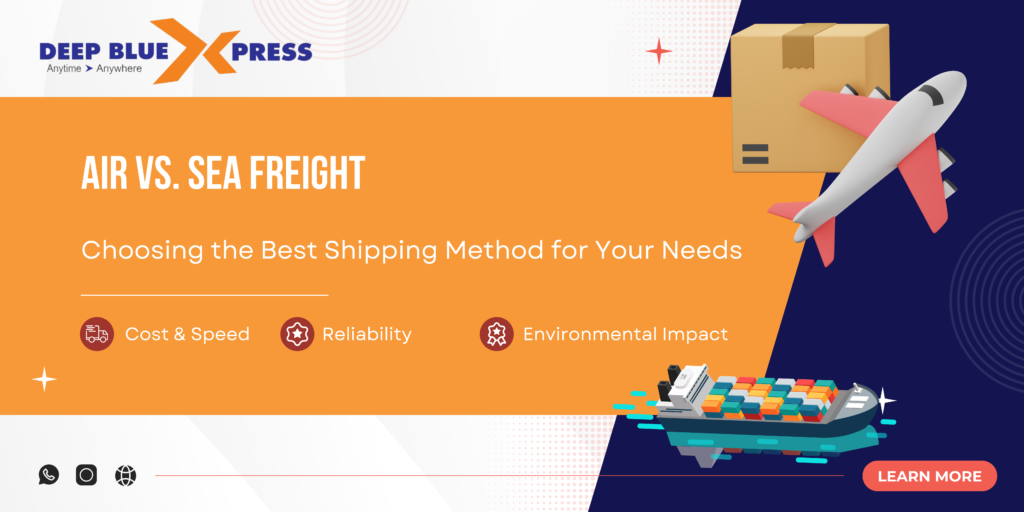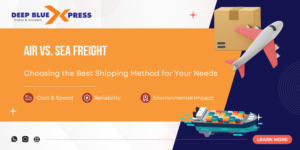In the vast expanse of global commerce, choosing the right shipping method can be pivotal. Whether it is for seasoned importers and exporters or only those who want to have a foot in international trade, the choice between air and sea freight is the essence of everything. Each mode of transport comes with its pros and cons; thus, the final selection is not easy but important. Let’s talk about which shipping method you should pick.
Speed: Racing Through the Skies or Sailing with the Tides.
Air freight is unquestionably the fastest mode of transport in the world. Through the clouds, airplanes can travel over long distances, and goods can reach their destination in a moment, sometimes even in hours. This is the quickest route for fresh products or time-dependent shipments where every second counts. Nevertheless, one should not disregard the fact that in sea freight, the vessels take their time to cross the oceans, which may take weeks or even months. This may not be appropriate for time-sensitive deliveries, but it is the best way to cut costs for large shipments or items with longer lead times.
Cost: Balancing Budgets and Bottom Lines
Cost considerations play a significant role in the shipping equation. Air freight, which is speedy and highly effective, is frequently too expensive for many shippers, and higher rates result. While ocean freight is cheaper by far, it becomes particularly inexpensive when applied to a bulkily shipped item. Although it might take a longer time to arrive, it is a preferred choice for businesses looking to optimize their bottom line.
Reliability: Weathering the Storms and Turbulence
Reliability is another factor to weigh when selecting a shipping method. Air freight is less dependent on the weather conditions and essentially more reliable while ocean freight can be disturbed by severe storms or rough waters. Indeed, air travel is not free from its own trouble which could be in the form of flight cancellation or air traffic congestion. The first and foremost thing in ensuring uninterrupted operations is to define and implement the possible risks and develop backup plans by any means of transport.
Environmental Impact: Sailing Towards Sustainability
In an era when ecological issues get attention, the environmental impact of shipping should not be ignored. Water transport is slower but more environmentally friendly than air freight in terms of carbon footprint per unit load. Moreover, it is worth noting that the maritime industry has been enhancing its commitment to cleaner technologies, as well as making greater improvements in fuel efficiency, in a bid to minimize emissions. In contrast, air freight bends carbon dioxide much higher per ton-kilometer, which leads to its low ecology-friendliness. For businesses committed to sustainability, choosing sea freight can align with their environmental goals.
Conclusion
In the Cold War between air and sea freight, there’s no one-size-fits-all answer. The right option for you will be determined by the numerous factors you consider, like the nature of the cargo you are shipping, budget limitations, product delivery timelines, and environmental aspects. Air freight is the best option for expedited delivery of urgent shipments the only drawback being the costly nature of this service. In contrast, sea freight offers a cost-effective option for the shipment of bulk cargo within a time frame, though it takes a much longer time when compared with air cargo.
Ultimately, the key lies in understanding your unique shipping requirements and striking a balance between speed, cost, reliability, and sustainability. By carefully evaluating the pros and cons of each shipping method, you will be able to choose the route that will finally lead your business to victory in the international arena.
Get in touch!
Deep Blue Xpress Limited are global freight forwarding specialist. We are committed to providing the best-ever logistics consultancy & engineering services for both large & medium-sized companies. Trust us to navigate your freight needs seamlessly, wherever your business takes you.
FAQ
Air freight is ideal for time-sensitive shipments or products with a short shelf life, such as perishable goods or high-value items. It’s also preferred for urgent deliveries or when you need to replenish your stocks quickly.
Sea freight has many benefits, as it is well suited for shipping goods with a longer lead time, along with large and bulky cargo shipments. It’s commonly used for shipping a huge amount of stuff, including machine bodies, vehicles, furniture, and non-perishable items.
Shipping costs for both air and sea freight are influenced by factors such as the weight and dimensions of the shipment, the distance traveled, fuel prices, customs duties, and handling fees. Work with your freight forwarder or shipping provider to obtain accurate cost estimates based on your specific requirements.
Air freight may be susceptible to delays due to weather conditions, flight cancellations, or airspace restrictions. Sea freight faces risks such as vessel delays, port congestion, and potential damage to cargo during transit. Understanding and mitigating these risks are essential for successful international shipping.




